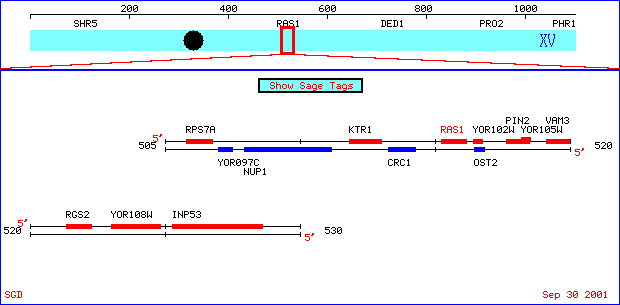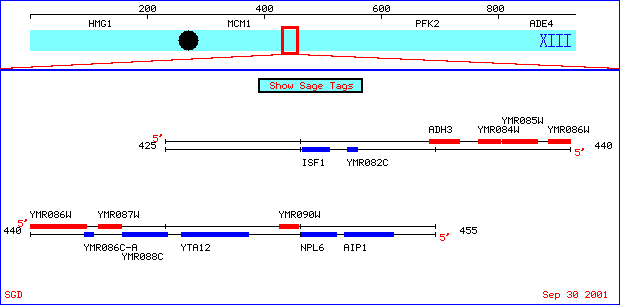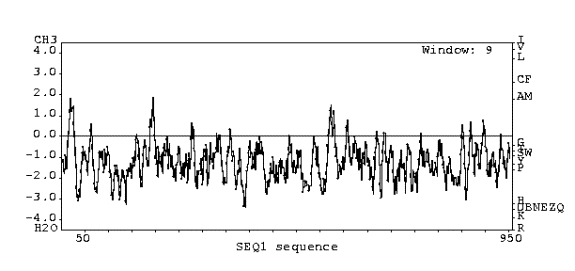
|
This web page was produced
as an assignment for an undergraduate course at Davidson College. |
My Favorite Yeast Gene
Saccaromyces cerevisiae, or commonly Brewer's yeast, was the first eukaryotic organism to be fully sequenced. Here, I have analyzed two yeast proteins, Ras1 which has been annotated and there is a wealth of information on, and YMR086W which is unannotated; we simply know that it is an ORF (Open Reading Frame).
Annotated: RAS1
Slowing the aging process has been a goal of biologists since long before the completion of the human genome. Aging is defined as, "a progressive decline in the ability to withstand stress, damage, and disease" (Jazwinski 1997). Whereas aging itself is not a disease, it affects the degree to which individuals are susceptible to diseases (Jazwinski1997). The Ras gene was the first cancer-causing gene discovered in humans, and is very similar to the yeast genes Ras1 and Ras2, all of which are integral in the aging process (CSHL 2001).

(Reproduction permission requested from SGD Curators)
Ras1 is located on chromosome 15 (portion of which is shown above) in S. cerevisiae, and is 64% similar to the mammalian Ras genes (SGD, 2001). Ras1 is a member of the GTP/GDP binding proteins whose signal transduction pathways play a role in the regulation of cell morphology, growth, and differentiation, functioning as a nutritional sensor in achieving a sort of homeostasis in the cell (Miller 1997).
The yeast Ras1 and Ras2 genes are elemental in determining life span. Together, Ras1 and Ras2 "establish a homeostatic balance by integrating growth, division, response to stress, and transcriptional silencing" (Jazwinski1997; ). By genetic manipulation in his lab, Jazwinski can over express Ras2 in yeast, which can lead to an extension of lifespan. Another gene, PHB1, may be essential for long life. Therefore, Jazwinski has concluded there is an additive effect among a number of genes that extend lifespan, suggesting more than one pathway to longevity (Jazwinski1997). Within the GTP signal pathways, the Ras genes determine the resources that are used in metabolic capacity and response to stress. In the absence of stress, Ras1 actually causes life to end earlier, while it aides in extending life when exposed to transient, mild heat stress by reducing the number of cells that died over a number of generations (Shama 1998; ). Furthermore, although over expression does not effect longevity, deletion prolongs the life span of cells (Proteome 2001).
Although yeast and mammals diverged in evolution over 1 billion years ago, the Ras genes have been highly conserved. In fact, the human Ras gene not only functions in yeast, but can completely substitute for the yeast Ras gene (CSHL 1997) Ras1 by itself is not an essential gene, allowing cells with null Ras1 loci to have a viable phenotype. This is mainly due to the presence of Ras2 which is 91% similar to Ras1 (Proteome 2001). It was shown that null mutants live 20-40% longer than the wild type (SGD, 2001).
Ras1 and Ras2 are important in the distribution of cell resources in determining life span. Understanding the Ras genes in yeast will allow us to further understand the aging process in humans, and eventually possibly alter the life span of individuals, in turn reducing the death rate in association to diseases. The similarity between the mammalian and yeast versions of this gene demonstrate how useful smaller organisms can be in conducting research into problems that plague all organisms alike.
Unannotated:YMR086W
YMR086W is an unknown ORF on chromosome 13, a portion of which is shown below:

(Reproduction permission requested from SGD Curators)
A Blast search revealed no genes that showed significant similarity outside of hypothetical genes. According to the Proteome, the closest related gene in humans is Semenogelin 2, which is extracellular and plays a role in reproduction (Proteome Y 2001). In S. cerevisiae, the most related is SAP155, which plays a role in cell cycle control, and is a protein phosphatase (Proteome Y 2001). The proteome database also revealed that the central region of the gene is glutamate rich, and that the deletion of the C-terminal half of the gene has no effect on viability (Proteome Y 2001). When performing a Kyte-Doolittle analysis (Pearson 2001) on the amino acid sequence, the following plot was created:

(Reproduction permission requested from Dr. Pearson at UVA)
This shows that the protein produced from this gene is not a transmembrane protein, as the value never exceeds the critical value of 2.0. This supports the structure of the Semenogelin 2 as it is extracellular. Structure and conserved domains could not be determined.
By using a Predator Secondary Structure search using the amino acid sequence, over 79% are random coils, almost 17% alpha helices, and 4% Extended strands, although the reliability is not always high enough to guarantee this accuracy. This information is difficult to analyze as there are no crystalized structures that are similar to this unknown ORF.
There is very little known about this
gene. Unfortunately, blast searches, kyte-doolittle analysis, predator
evaluations, and many other searches revealed little information that would
allow one to infer the cellular and biological role of this gene. However,
more information is constantly added to the databases. Eventually, either
this ORF will be found to be nonsense, or more information will be discovered
that will allow valid conclusions to be drawn.
Jazwinski, S. Michal. "The Biochemistry and Molecular Biology of Aging." 11 October 1997. <http://www.medschool.lsuhsc.edu/bioc/Department/Newsletter/NEWSLTR-JAZ.html> 9/30/01.
Miller, Michael. "Heat Shock, Future Shock at NIA's 8th Shock Lecture." 29 July 1997. <http://www.nih.gov/news/NIH-Record/07_29_97/story05.htm> 9/30/01.
Pearson, William R. "Kyte-Doolittle Hydropathy Plots." 2001 http://fasta.bioch.virginia.edu/fasta/grease.htm 9/30/01.
Pole Bio Informatique Lyonnais. "Predator Secondary Structure Predictor." 2001. <http://npsa-pbil.ibcp.fr/cgi-bin/secpred_preda.pl> 10/01/01.
Proteome, Inc. "Ras1." <http://www.proteome.com/databases/YPD/reports/RAS1.html> 9/30/01.
Proteome, Inc. "YMR086W ." <http://www.proteome.com/databases/YPD/index.html> 9/30/01.
SGD. "Ras1 Basic Information." 2001. < http://genome-www.stanford.edu/Saccharomyces/> 9/30/01.
Shama S, Lai CY, Antoniazzi JM, Jiang JC,
Jazwinski SM. "Heat stress-induced life span extension in yeast." 15
December 1998.
<http://www3.ncbi.nlm.nih.gov/htbin-post/Entrez/query?db=m&form=6&uid=99069164&dopt=r>
9/30/01
Davidson College Biology Department
© Copyright 2001 Department of Biology, Davidson College, Davidson, NC 28036